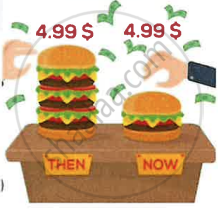Advertisements
Advertisements
प्रश्न
With reference to the picture given below answer the questions that follow:

- Define the concept.
- Explain any three types of the concept.
उत्तर
- Inflation: Inflation is defined as a consistent/sustained increase in the aggregate price level and a fall in the value of money. Inflation is commonly understood to be a situation in which prices of goods and services persistently rise at a fast pace. It is important to note here that inflation refers to a state of rising prices and not a state of high prices. Moreover, every type of rise in price level is not called inflation. A substantial rise in price or rise in price at fast rates is called inflation. A substantial rise in price or rise in price at fast rates is called inflation. Another noteworthy point in this regard is that one time rise in the price level does not mean inflation. It is the persistent rise in the price level which is called inflation. Further, a rise in the price level for a short period of time, say 6 months or a year, is not regarded inflation. It is only when price increases continuously over a long period of time that it is treated as inflation.
- Following are the main features of inflation:
- Prices rise in the state of inflation.
- Prices rise continuously over a long period of time.
- Prices rise at faster rate.
- Rise in prices of goods may not be equal for all goods and services.
- Rate of Inflation: Rate of inflation refers to the rate at which inflation is increasing, over a specific period. In other words it is the rate of increase in prices over a given period of time.
The inflation rate is calculated using the consumer price Indies between two years. If the consumer price index (CPI) for this year is CPI1 and the consumer price index last year is CPI2, the rate of inflation between this year and last year is calculated as
Rate of inflation = `("CPI"_2-"CPI"_1)/("CPI"_1)xx100`
The consumer price index (CPI) measures the average change between two given periods in the prices paid by consumers for a representative basket of goods and services.
- Following are the main features of inflation:
- Types of Inflation:
- Creeping Inflation: Creeping inflation is the first stage of inflation. When the rise in prices is very slow, like that of a snail or creeper, it is called creeping inflation. In terms of speed, prices rise about 2 per cent annually, which is regarded as safe and essential for economic growth.
- Walking or Trotting Inflation: When prices rise moderately, and the annual inflation rate is in the single digits, it is called walking or trotting inflation. In other words, the rate of price rise is in the intermediate range of 3 to 6 per cent per annum or less than 10 per cent. Walking inflation is a warning signal for the government to control it before it turns into running inflation.
- Running Inflation: When prices rise rapidly at a rate or speed of around 10 per cent to 20 per cent per annum, it is called running inflation. Such inflation adversely affects the poor and middle class. Their economic position becomes worse during periods of inflation. The government should take the necessary steps to control it; otherwise, it will convert into hyperinflation.
APPEARS IN
संबंधित प्रश्न
Define inflation.
Briefly explain three determinants of Cost-push inflation.
What is galloping inflation?
Can inflation lead to economic development? Give a reason for your answer.
The income of a person who carries the risk bearing function is called as ______.
What will happen to the value of money when price level rises? What is this phenomenon known as?
Observe the relationship of the first pair of words and complete the second pair.
During inflation the debtors gain and ______ lose.
Inflation means ______.
Identify the incorrect statement from the following:
Read the following statements - Assertion (A) and Reason (R). Choose one of the correct alternatives given below:
Assertion (A): Inflation is a continuous rise in the general price level.
Reason (R): Inflation increases standard of living.
